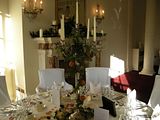
I don't generally approve of plants in houses - they never look quite comfortable, not in my home, at least. I've been lucky enough to travel to places where Ficus benjamina are the size of oak trees and Monstera deliciosa are climbing towards a forest canopy. For me it just doesn't feel right to grow them next to the TV.
 But it's a plantaholic's prerogative to change their mind. So I must confess I was secretly delighted to discover at Tatton what could become my ideal houseplant.
But it's a plantaholic's prerogative to change their mind. So I must confess I was secretly delighted to discover at Tatton what could become my ideal houseplant.
The Hawaiian palm (brighamia) is not so much a jungle escapee desperately pining for the rainforest - it's more of an endangered species in need of fostering. Raised from seed by Dutch nursery Plant Planet, these beautiful plants can be grown happily in your living room. And as there are only seven specimens left in the wild, the IUCN is desperate to bring attention to them.
That's a pretty good reason to grow one. They need little watering and have the added bonus of flowering in deepest, darkest winter. I think I have the perfect spot in mind.
Camilla Phelps, Gardening Editor
pollen-flowers posted a photo

ballroom - Buxted Park - 009-13.jpg

PurpleWhite Flowers - DSC08753.jpg
Keywords:
Asim Shah posted a photo:
A few years ago if someone had mentioned gabions I wouldn't have known what they were talking about. They were something that was used in civil engineering, large scale industrial landscaping - a million miles away from domestic gardens. Now it seems they are becoming the cool thing to have.
 At Tatton there are gabions in the show gardens, in the back to backs and on the trade stands - people are taking home DIY versions!
At Tatton there are gabions in the show gardens, in the back to backs and on the trade stands - people are taking home DIY versions!
Basically a gabion is a metal - usually steel, cage filled with stones/rocks or various heavy materials. They are usually used to retain soil in banks and terraces or as barriers. I've seen taller, slim ones used as a wall and smaller, cubed ones made into seats - the permutations are endless, as demonstrated by the two young designers of the Visionary garden, Cubed3, at this year's Tatton.
 This gold medal winning design is a modular scheme, gabions are linked together like building blocks and used in different ways - some are filled with rocks as foundations, some are filled with soil and planted and some are placed in the pond, allowing you to walk over the water's surface. Larger cages have been left empty and plants are able to grow up through them - it's very effective.
This gold medal winning design is a modular scheme, gabions are linked together like building blocks and used in different ways - some are filled with rocks as foundations, some are filled with soil and planted and some are placed in the pond, allowing you to walk over the water's surface. Larger cages have been left empty and plants are able to grow up through them - it's very effective.
On the Edible Trends garden the Reaseheath College team have filled their gabions with carefully placed layers of stones and wood in decreasing sizes, creating a very pleasing pattern and a haven for wildlife. Apparently it took them ages to do but it looks fantastic.
A very 'green' way to fill your gabions is with odd bits of bricks, slates and tiles left over from building jobs, plus any empty bottles you may have accumulated. This is what they have used on A Place for Waste, another gold medal winning garden.
As you look around the show you will see all sorts of shapes and fillings and gabions used in many ways. I am feeling quite inspired and am planning to try something with sempervivums and I rather like the idea of turf cubes.
Info from:
Private Club



No comments:
Post a Comment